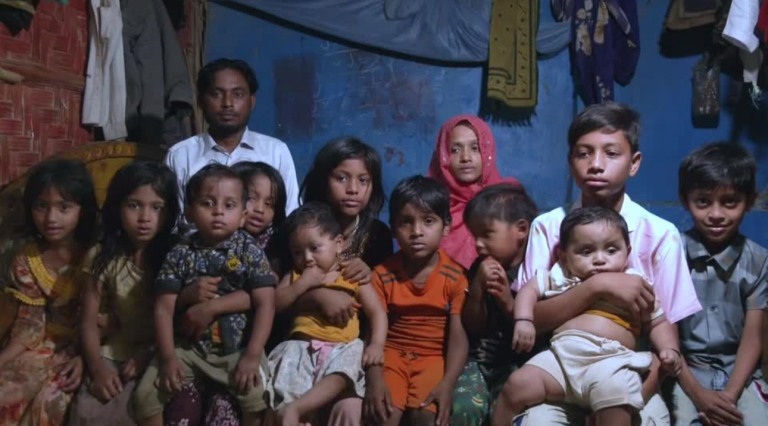
New York, N.Y. — In the sprawling refugee camps of Cox’s Bazar, Bangladesh, home to over a million Rohingya fleeing persecution in Myanmar, a fresh crisis looms.
The United States Agency for International Development (USAID), long a lifeline for these displaced communities, has drastically reduced its funding, sending shockwaves through an already fragile humanitarian ecosystem. The cuts, part of a broader policy shift under President Donald Trump’s administration, threaten to unravel years of support, leaving refugees like Majuna Khatun grappling with fear for her six-month-old child’s future.
“It’s terrifying,” Khatun said, cradling her baby at a rehabilitation center in Kutupalong camp. “Without aid, how will we feed our children? How will we survive?” Her words echo a growing despair among the Rohingya, whose survival has depended on international assistance since the 2017 exodus driven by Myanmar’s military crackdown, labeled a genocide by the United States.

The USAID reductions, announced earlier this year, have slashed contributions that once accounted for nearly half of all aid to the Rohingya, totaling $2.4 billion since 2017. The impact is immediate and stark.
The United Nations World Food Programme (WFP), a primary channel for U.S. aid, warned that without new funds, food rations for refugees could drop from $12.50 to $6 per month—far below what’s needed for basic nutrition. In March, the WFP slightly reduced rations, a move officials said was unavoidable amid a global shortfall exacerbated by the U.S. cuts.
“These camps are ground zero for the impact of budget cuts,” U.N. Secretary-General António Guterres said during a March 2025 visit to Cox’s Bazar. “People will suffer, and people will die if we don’t act.” His warning underscores the ripple effects: five U.S.-funded hospitals have scaled back services, affecting 300,000 refugees’ access to healthcare, according to camp officials. Cholera and scabies outbreaks, already straining resources, now risk spiraling unchecked as water sanitation projects falter.
For refugees like Forid Alam, a 36-year-old father at Balukhali camp, the cuts feel like a betrayal. “We’re grateful for past help, but now we’re forgotten,” he said. “No jobs, no freedom to move—aid is all we have.” The camps, tightly controlled by Bangladeshi authorities, offer little opportunity for self-reliance, making external support critical. Yet, the scabies, coupled with some European donors also pulling back, has left a gaping hole in funding.
The crisis compounds existing challenges.
About 70,000 Rohingya fled to Bangladesh in 2024 alone, driven by hunger and conflict in Myanmar’s Rakhine state, where the Arakan Army’s clashes with the junta displaced thousands more. Repatriation, seen by Bangladesh as the ultimate solution, remains elusive. Myanmar’s verification of 180,000 refugees as eligible to return—out of 800,000 proposed—has stalled, with refugees like Shafiqur Rahman dismissing it as “eyewash.” Past attempts in 2018 and 2019 failed when Rohingya refused to return, citing fears of renewed persecution.
Aid workers warn that the funding shortfall could fuel darker outcomes.
David Bugden, coordinator for NGOs in Cox’s Bazar, noted that reduced services correlate with rising crime, human trafficking, and radicalization risks. “When people are desperate, they’re vulnerable,” he said. Reports of militant groups like the Arakan Rohingya Salvation Army recruiting young men from the camps add urgency to the need for stability.
A glimmer of relief came in late March when the U.S. pledged $73 million through the WFP, a move refugees welcomed as a “gift” before Eid al-Fitr. But experts say it’s a drop in the bucket compared to the $15 million monthly shortfall the WFP faces to maintain full rations. “It’s not enough,” said Mohammed Mizanur Rahman, Bangladesh’s refugee commissioner. “We need consistent, long-term commitment.”
Bangladesh’s interim government led by Muhammad Yunus, in power since August 2024, has leaned on international visits—like Guterres’—to spotlight the crisis. Yet, with global attention scattered and donor fatigue setting in, the Rohingya risk slipping further into neglect. “The international community cannot turn its back,” Guterres urged, pointing to climate-driven floods that further endanger the camps.
For now, refugees cling to hope amid uncertainty.
“We pray for help,” said Abdur Salam, an 80-year-old camp resident. “Without it, we are simply going to starve.” As USAID’s retreat reverberates, the world faces a test of its resolve to protect the Rohingya—one of the most vulnerable populations on earth. The clock is ticking, and for many, survival hangs in the balance.